Special | How Sugarcane Determines the Politics of Maharashtra
This is the third and final part of a series investigating the fallout of Maharashtra’s sugar boom. Read part one here and part two, here.
Beed’s Majalgaon tehsil is filled with families who have migrated from different parts of Maharashtra. It is late November – the beginning of cane cutting season. Women are busy setting up pots, pans and the ration they have brought from their villages. The makeshift tents, made of black tarpaulin sheets and sugarcane stalks, can barely fit three people. They are lined with medium-sized blue drums filled with water at the entrance. Bathrooms sit beside the tents, without roofs. Young boys and girls, along with cattle, are resting. This is their home for the next six months.
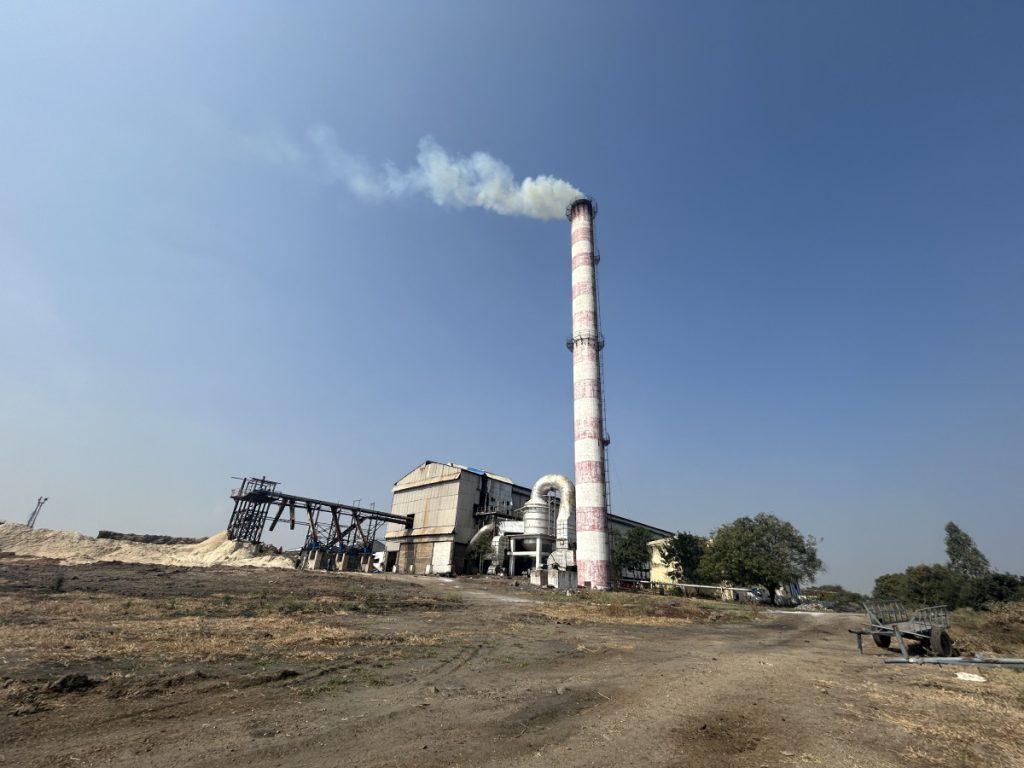
Chhatrapati Sahakari sugar factory in Majalgaon. Photo: Amitha Balachandra.
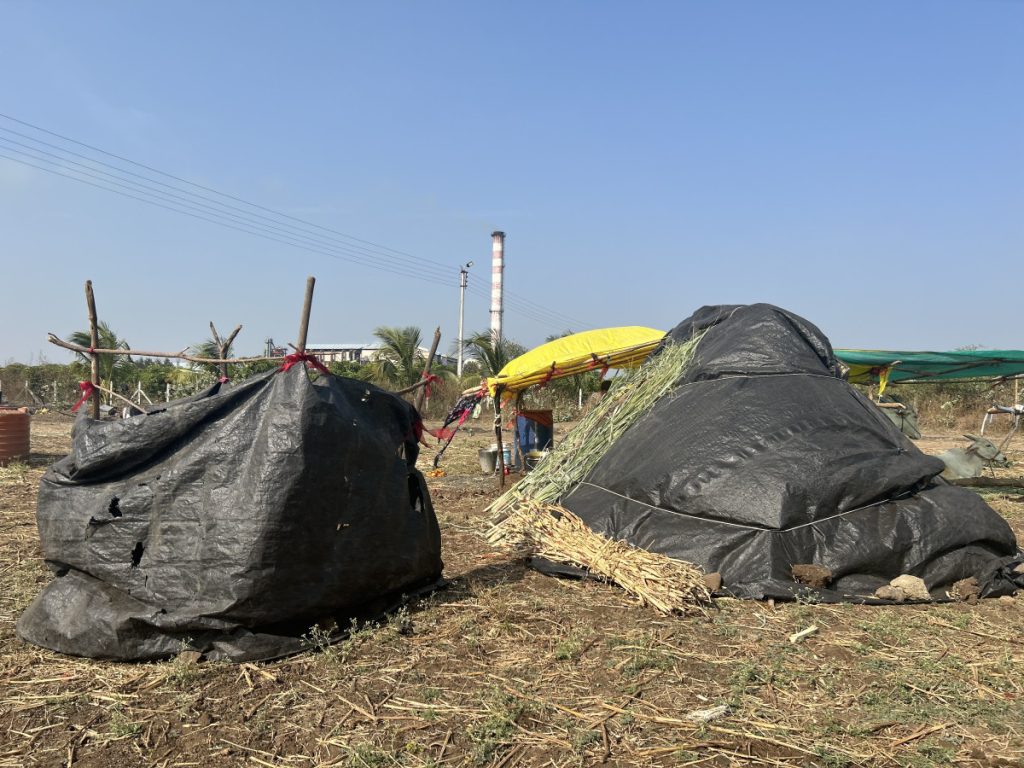
Workers’ tents in the backdrop of the factory. Photo: Amitha Balachandra.
As workers set up tents in the backdrop of sugarcane farms, the stench of the sugar factory that towers over them is nauseating. Their boss is seated at home, a few kilometres away, worried about his business.
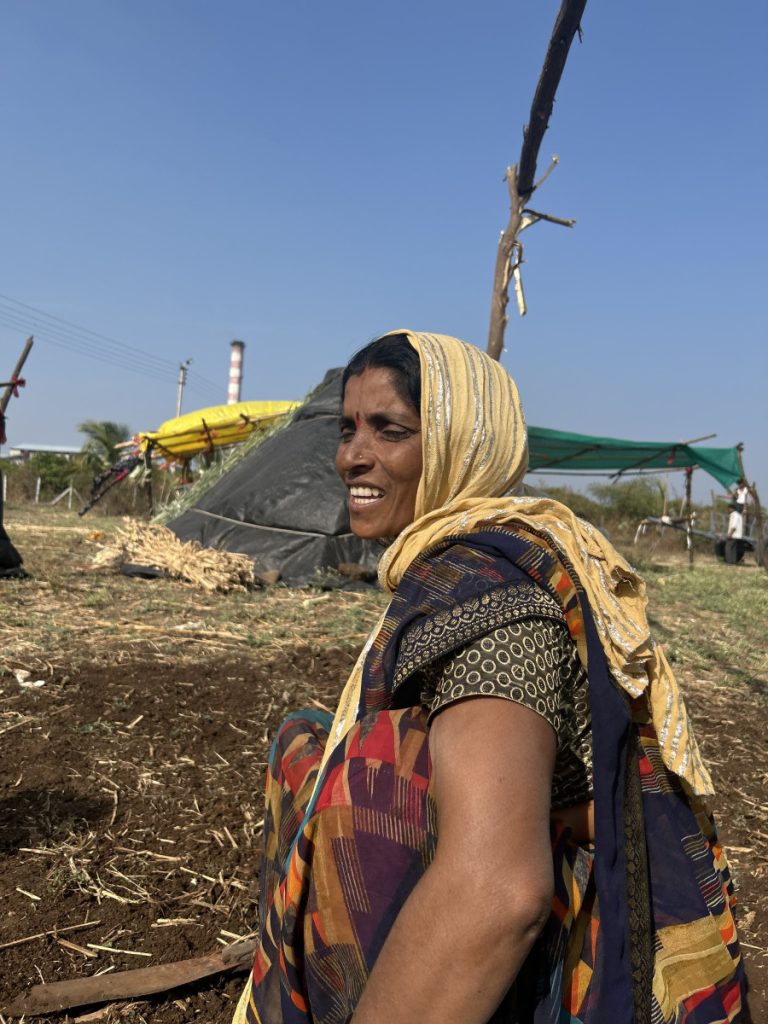
Migrant worker sets up her tent behind the factory. Photo: Amitha Balachandra.
Almost everyone in Majalgaon knows who Mohan Bajirao Jagtap is. He is the vice chairman of the Chhatrapati Sahakari sugar factory in the tehsil. He is also a member of the Sharad Pawar faction of the NCP.
2024 has not been a good year for him.
Dressed in a striped white formal shirt, hair parted to his right, a tika on his forehead, and black half-rim glasses, Jagtap meets The Wire, flanked by security and his staff members. It is two hours before noon, there are no visitors yet, and the wait time is barely half an hour.

Mohan Jagtap at the entrance of his house in Majalgaon. Photo: Amitha Balachandra.
We have come armed with information about a looming water crisis in Marathwada, driven in a large part by the sugar industry’s unrelenting extraction of groundwater supply. But Jagtap is not perturbed by the drop in water levels, caused by the rise of the water-thirsty sugarcane plantations in a dry region.
“In our area, there is no problem with water. A year ago, there was a problem, that is why sugarcane had gone down. Now, there is water. So, next year, sugarcane will grow more,” says Jagtap, matter-of-factly.
We also presented our findings about the depleted soil in the region. But that does not worry him either.
Jagtap is fresh off his electoral loss to Prakash Solanke, a member of the rival Ajit Pawar NCP faction and the chairman of the powerful Loknete Sunderraoji Solanke co-operative sugar mill in Beed. Solanke is a four-time MLA, who has returned to power in Majalgaon with a little over 5800 votes.
In part three of the six-month investigation by The Wire into Maharashtra’s sugar boom, we look at the powerful political and economic interests that make the industry seemingly immune to the ecological and health consequences of a cash crop that’s drinking up the water, poisoning the land and sickening the local population.
The sweet grip of power
The first lesson in the politics of sugar that farmers learn is how their vote determines who will buy their sugar and up the food chain: politics and sugar prospects remain in lockstep.
Mahesh Magar, a farmer in Dharashiv district of Marathwada, contends his brother was not able to sell his produce to the sugar factory he used to regularly sell it to. The reason: Magar’s brother is in the opposition party in the region. He then had to sell the sugarcane to another factory. Several other farmers The Wire spoke to said factory owners influence the local vote to a large extent.
“You build a sugar factory, you get a commission while erecting a factory. Then there are about 5,000 farmer members. They are obliged to you. Then you have a nexus with the fertiliser company. You have a nexus with the tractor company. So it becomes an interlocking part of a farmer's whole life,” says economist H.M. Desarda, who has often questioned the government’s policies – such as the Jalyukta Shivar Abhiyan – that he contends has failed to address the agriculture distress in the region.
Jagtap, who runs a sugar factory in Majalgaon, disagrees. He says things have begun to change. “When the factories were few, the farmers had no choice. That is why the farmers were connected to the factory and the chairman. Now, there are a lot of factories. So, there is no need for the farmers and the chairman to meet. If you don’t take [the produce], someone else will take,” says Jagtap.
The evidence, however, stacks up against him. Before the Maharashtra elections in 2024, reports said at least 61 contestants had links with sugar mills in the state; 35 of those contestants won the state elections.
One of the biggest sugar factories in Beed, the Jai Bhawani Sahakari sugar mill, is run by the former MLA of Georai constituency, Amarsinh Pandit. His brother Vijaysinh Pandit is the current MLA of the same constituency.
Several current ministers, including Animal Husbandry and Environment minister Pankaja Munde of the BJP, as well as former ministers such as Diliprao Deshmukh and Amit Deshmukh of the Congress party, are prominent sugar barons in the region.
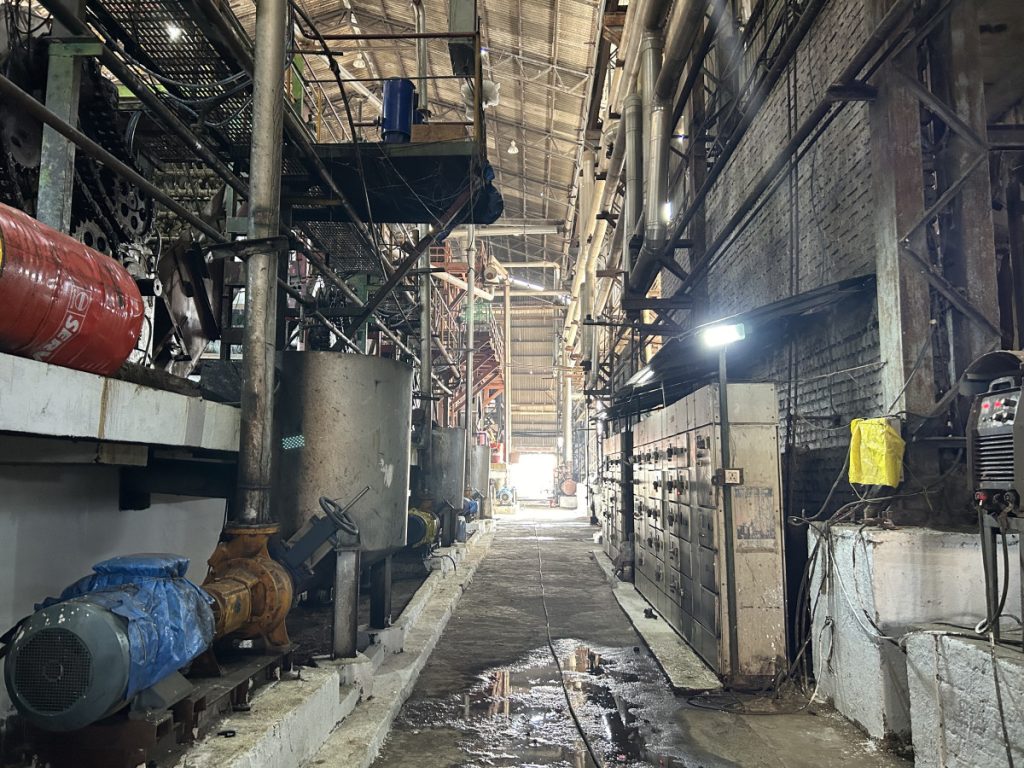
Inside Chhatrapati Sahakari sugar factory in Majalgaon. Photo: Amitha Balachandra.
Research during political cycles in Maharashtra till 2005 shows how funds are misappropriated in politically-controlled mills during election years. “Just before the election years, the price paid out actually goes down. What I found is that this reduction in sugarcane prices seems to happen mainly in mills where there's a political connection, where the chairman is a politician, is running for election or has some other family member connected who's also running for election,” says Sandip Sukhtankar, professor at University of Virginia, USA, who authored the research paper on politics in the sugar sector. He says farmers may get compensated on being elected by raising the sugarcane price.
Even though the number of private mills have risen, which in theory, would make the market more competitive, owners continue to have political clout. Economist Desarda says several co-operative mills that were in debt privatised their mills. “What they [politicians] did is liquidate those cooperative sugar mills, because they had huge land and they had the machinery and the whole setup. They have privatised,” he says.
Sugar barons: Immune to criticism
The sugar industry has cultivated a certain immunity to criticism. Despite several reports on environmental and health irregularities, there seems to be a lack of accountability. In 2020, a group of researchers in Italy and USA did a systematic review of the environmental impact of sugar across the world. They included studies on issues such as water pollution, air pollution, and impact on biodiversity, among other things.
India’s Environmental (Protection) Act 1986 mandates that every industry, including sugar, needs to treat their wastewater before they release it to water bodies. Yet, reports show that water pollution is one of the biggest issues of the industry. Sugar mills and distilleries are one of the 17 most polluting industries, according to data released by the Central Pollution Control Board.
“By law, sugarcane factories have to follow water efficiency, water balance. They can't allow waste water to flow [without being treated]. The Pollution Control Board (PCB) does not monitor all that, even though they are mandated to do so. If the State PCB gives notice to sugarcane factories to close down, then they'll use farmers as a shield saying they will come and protest. Environmental impact [assessment] is not done. Even if it is done, there is no action,” says public policy expert Donthi Narasimha Reddy, a visiting senior fellow at the Impact and Policy Research Institute, Delhi.
Politicians themselves would be the ones who could put in place stricter oversight of the sugar industry, including monitoring of the environment, labour rights and health outcomes. However, with the political nexus, such actions would only add additional burdens to their incomes through their ownership of sugarcane plantations, mills and distilleries.
For instance, in Maharashtra, several reports have documented how hysterectomies are rampant among migrant women. Yet, it seems to continue unabated. Experts we spoke with said norms continue to be flouted because the ones who make the rules are the ones who control the factories.
Media reports on the issue prompted the Bombay HC to appoint an amicus curiae to give recommendations on improving the working conditions of sugarcane labourers. Among the list of suggestions are better working conditions and facilities for women, and enforcement of labour acts. The court has asked the state to implement this from the next cutting season.
Nearly half of the state’s proposed factories are in Marathwada
While sugarcane production is thriving in the region, politicians like Jagtap, who run co-operative factories, are now batting to impose restrictions on private factories. Most co-operatives are ailing, with the state regularly handing out loans to politicians they favour.
Interestingly, Jagtap’s opponent, Prakash Solanke’s factory was given a loan guarantee days before the state elections.
In a state which has the most sugar mills in the country, Marathwada accounted for a third of the 200 sugar mills that crushed cane till April this year. 60 factories are currently functioning in the region.
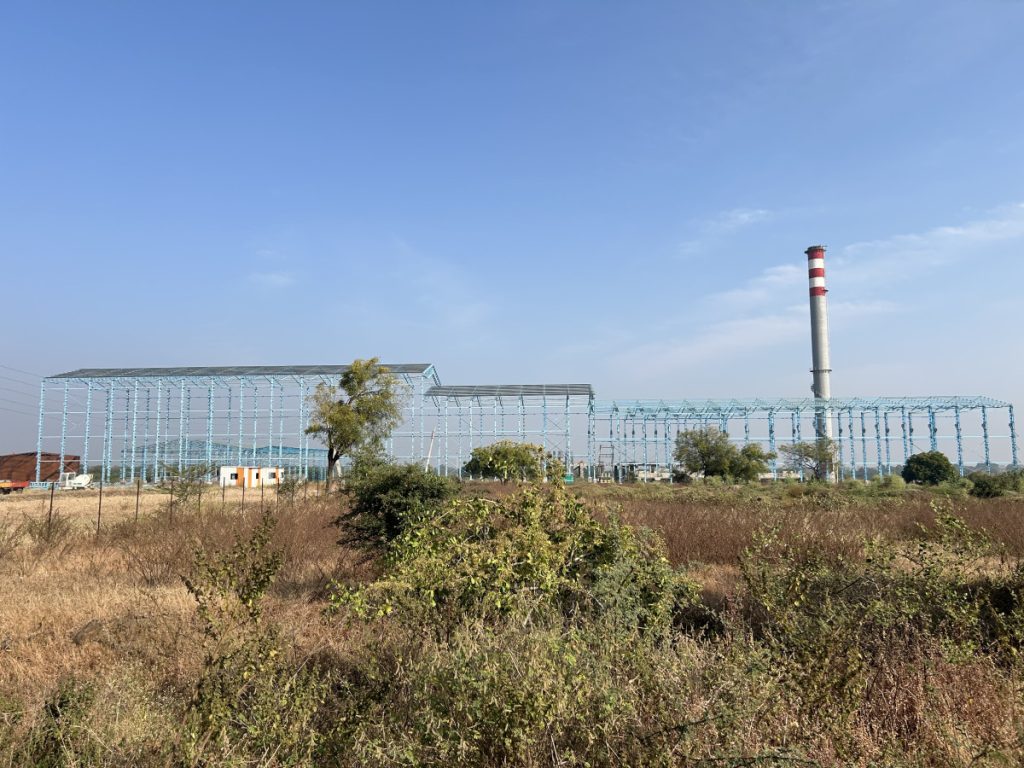
Travelling within Beed, The Wire found a few under-construction factories. Photo: Amitha Balachandra.
In 2015, at the peak of droughts in the region, water expert Madhav Chitale had said that there was “no justification” to continue growing sugarcane in the region. And yet, exactly five years later, during the 2022-23 crushing season, Marathwada’s production of sugarcane had substantially increased. By 2022, government data shows that the area and production of sugarcane in districts of Marathwada had seen an overall increase, as our first story in this series showed.
Taking cue from the Madhav Chitale committee recommendations, the Maharashtra government said no new sugar mills will be set up in Marathwada for a period of five years.
Experts say this was only a verbal declaration. “There was only a political statement. I was the groundwater director at that time. We framed the rules. They are yet to be approved by the government,” says the former commissioner of sugar in the state, Shekhar Gaikwad.
The Wire obtained access to the number of factories that have been under construction or are sitting on licenses since 2008. Forty out of 91 factories are in the Marathwada region. A tenth of the total factories in the region are in Beed alone. Sources said at least four additional proposals for sugarcane factories are under consideration as of last year, one of which is in Beed district.
Government’s sugarcane push: A policy problem
Despite the verbal declaration that there would be no new sugar mills in the region for five years, governments, both at the centre (in the form of ethanol production) and the state, continue to push sugar making it a sure bet for factory owners. Like Jagtap, several other politicians helming these factories benefit from this system. And the only real limitation appears to be that new sugar mills cannot be too close to an existing sugar mill.

Making of sugarcane’s byproduct inside Chhatrapati Sahakari sugar factory. Photo: Amitha Balachandra.
“I don't think politicians are aligned with the people. Generally speaking, they will not think about long-term issues, like depletion of groundwater. And there is no policy because the only legal framework is sugar control order. And they are talking only about aerial distance,” says Gaikwad.
What he means is that there cannot be more than one sugar factory in a 25 km-radius. This seems to be the main criteria to get a license, without really considering the groundwater availability, community health concerns, pollution and land use impacts.
“Anybody can apply to the commerce ministry. And the only thing that goes through the sugar commissioner, after certification by survey – a technical certificate, showing that the new place where licence is demanded has definitely more than 25 kilometres as aerial distance. Right from Pune to Nanded, there is no place where you can fit in a new mill, “says Gaikwad. Perhaps this is the reason why the number of new proposals under consideration in 2024 was in single digits.
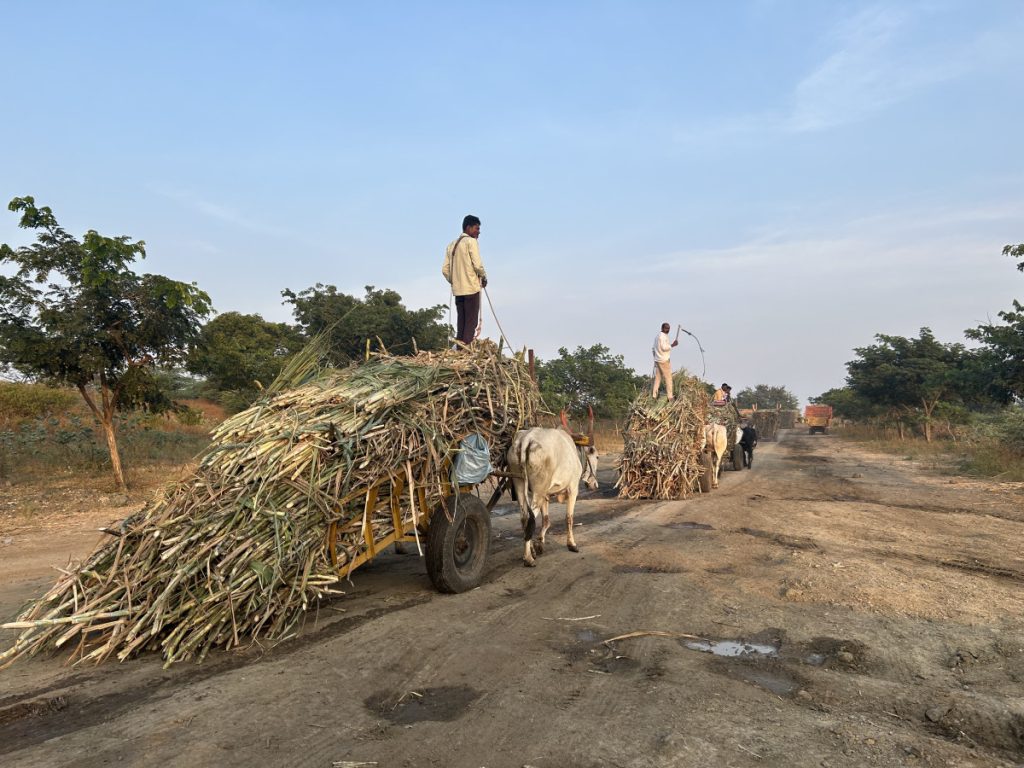
Cane being taken to a sugar factory in Beed. Photo: Amitha Balachandra.
Despite farmers already getting higher returns from sugarcane than other crops, factories seem to also benefit because of the export policy and byproducts, such as ethanol. The Fair and Remunerative Price (FRP) is set based on the recovery rate of sugar, which is the ratio of sugar produced versus cane crushed. The centre fixed Rs. 340 per quintal for 2024-25 for a recovery rate of 10.25%. This is the price a sugar mill must pay for every quintal of sugarcane. Farmers have been seeking a higher FRP due to rising input costs and changing crop yield. Meanwhile, the sugar industry has also been pushing for a higher minimum support price (MSP) for sugar.
As for co-operative sugar factories with debt, the ruling party in the state recommended loans for at least five of them early this year.
Agriculture and water experts say that policies such as free electricity, push to increase ethanol production (with a focus on increasing distilleries), loans to factories, and subsidies for fertilisers are the problem. “Almost all states are doing the same thing by giving free electricity to the farmers. And that's also creating chaos because water is getting freely pumped, so no one is bothered about that. The mechanism we see in terms of promoting solar for irrigation purposes. And our primary observations show that in groundwater-depleted areas, this 24-hour solar available electricity needs to be studied,” says Eshwar Kale, senior researcher at Watershed Organisation Trust.
If subsidies to sugar cultivation were pared back, many politicians with interest in the sugar industry would suffer as a result. Any attempt to reverse the trend needs political will according to economist Desarda.
“You see, they should withdraw all the support to sugarcane and sugar factories. They can give the additional money to promote alternative crops. Farmers will turn to dairy farming, and oilseeds and pulses, if there is assured price, and assured post-harvest price. The political class look at their short-term interest from one election to another,“ he says.
The sugar commissionerate, meanwhile, in response to The Wire’s questions on our findings said “the government doesn’t push for sugarcane cultivation, but it is the farmers’ choice”. The commissionerate said “they cannot ask farmers who have assured water sources to not plant sugarcane”. We were also told that the “pollution control board looks at the environment aspect” and that the sugar (control) order only allows them “to give licenses for cane crushing”.
Farmers, for now, are focused on growing sugarcane despite shrinking water availability in the region. As of April 2025, dams in the region had over 40.49% water storage. The storage was at 18.05% the same time last year due to poor rainfall the previous year. Factory owners like Jagtap are interested in profiteering amidst competition.
“Because of the other factories, we are not able to get enough sugarcane. So we are producing only half the amount of sugarcane. The less sugarcane we produce, the bigger the loss. If the factories keep increasing, some of them will close down,” says Jagtap. But if Jagtap does win the next election, his fortunes may change.
Reporting for this story was supported by the Environmental Data Journalism Academy – a programme of Internews’ Earth Journalism Network and Thibi.
Data analysis for this series and the full methodology can be accessed here.
The Wire is now on WhatsApp. Follow our channel for sharp analysis and opinions on the latest developments.




